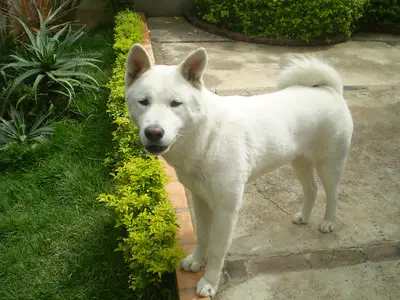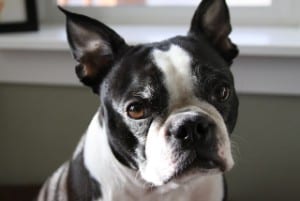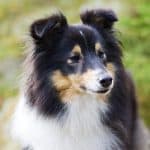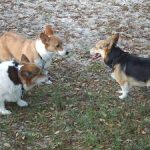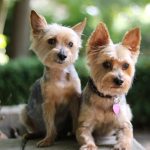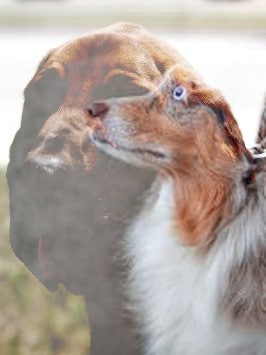
What do you get if you cross a Bloodhound with an Australian Shepherd dog?
Although this sounds like the start of a bad joke, this mix of these two popular breeds does exist.
And if you are looking for a punchline for the joke, the answer is that you will get a dog that could potentially hunt, track and herd!
How about that for some personality traits?!
But because we are talking about a mix between two breeds of dogs, it is difficult to know the exact balance of traits you will get.
After all, any type of breeding is a bit like a lottery!
But to give you more of a clue let me start by meeting the parents…
Breed History
The Bloodhound Australian Shepherd mix is a breed that comes from pairing the Australian Shepherd with a Bloodhound.
This is a truly unique breed combination, pairing hunting and tracking with herding for an interesting dynamic.
This is a newer breed and is not very traditional in terms of breeding, so there isn’t a whole lot of history here with this type of dog yet.
However, they seem to have been gaining in popularity in recent years, so we’re sure we’ll see more information as interest in this breed grows.
Meet the Parents of the Bloodhound Australian Shepherd
The parents of the Bloodhound Australian Shepherd mix are the Bloodhound and the Australian Shepherd. As we said earlier, mixing the tracking and hunting prowess of the Bloodhound with the herding instincts of the Australian Shepherd makes for a truly unique breed.
Bloodhounds
Let’s first take a closer look at Bloodhounds. Originally bred in ancient Europe and the Mediterranean, Hounds were used as hunting and tracking animals for hundreds of years. They helped early hunters and gatherers in tracking elusive prey, while also lending powerful hunting skills to deliver the kill.
In more recent centuries, they were bred and used by European nobles to help them hunt deer, stags, and wild boar on their lands. A pack of Bloodhounds was the best way to track down and kill prey. This practice only continued until firearms started to find common use, rendering hunting animals much less useful.
Bloodhounds are some of the best tracking dogs in the world, and they owe that to their amazing sense of smell. They have been known to be able to track smells from up to 20 km away, which is an immense distance!
When a Bloodhound gets ahold of a scent, they will track it tirelessly, sometimes going days without sleep until they track down the source of the scent. With high stamina and endurance, they’re able to keep tracking long after when most breeds of dog would give up the chase.
As far as temperament goes, these dogs are very patient and kind, making them good with children. Their immense stamina means they need a lot of exercise, typically requiring multiple walks a day to get their energy out.
Australian Shepherds
Australian Shepherds are a distant cousin of the German Shepherd, sharing the same natural herding instincts when around livestock like sheep, cows, or goats. Even though they have Australia in their name they were actually bred in the United States and have since become closely associated with cowboy life.
These dogs are tough and lean, making them great ranch dogs, also in part to their great shepherding instincts. They are adept at moving livestock from one point to another, making them highly sought after with ranchers and farmers.
Aussies even go so far as to shepherd children, birds, or other dogs. They just want to shepherd something, and they’ll take anything they can get. This breed is also known to be quite clever, which can be a plus and drawback for many owners. You’ll want to keep a close eye on these dogs if you ever get one.
Similarly, to Bloodhounds, Aussies have huge amounts of stamina and energy and will require multiple walks or runs every day to get out their energy. Sedentary dog owners beware, as these dogs will make sure you get up and move every single day!
Size and Life Expectancy
When bred together, the Australian Shepherd and Bloodhound create an adorable, hard-working breed that is intelligent and loves to learn and work. The Bloodhound Australian Shepherd mix will grow to around medium size, just like their parent breeds.
Their life expectancy can range anywhere from 9 years to 12 years for a healthy member of this breed. While some life expectancies may fall outside this range, this is the average life span you can expect for this dog.
Appearance
Bloodhound Australian Shepherd mixes have brown or blue eyes, with a slightly pointed muzzle. Their ears are set high on their heads and triangular in shape, drooping when at rest much like their Bloodhound parents. Their ears become erect when excited or feeling threatened. They have a short, straight tail.
They share many of the same characteristics and physical traits of their parents, including their droopy ears and light-colored eyes.
Personality
This breed of dog is especially adept at watch guarding. They are great guard dogs or sentries because of their patience, diligence, and disposition to work hard. They love to bark and warn their owners of any potential dangers they may come across and will defend their family and home with surprising ferocity.
Despite their watchguard demeanor, they aren’t all work. They are also playful and will act extremely happy to see their owners. Their patience and stern demeanors make them great dogs to have around children.
Feeding and Care
Bloodhound Australian Shepherd mixes require around 30 to 60 minutes of exercise per day, preferably at a high capacity. They need this to get all their energy out, otherwise they can quickly become depressed or anxious.
These are dogs that typically require wide open spaces to get all their energy out in. But if you don’t have a huge field for them to run around in, a large yard is still sufficient. Alternatively, you could also opt to go for runs with them on a regular basis.
Because this breed likes to take the lead, they will require a firm and confident owner to properly handle them. With a lax owner, they can quickly become too much to handle, acting like the house belongs to them and you have to do what they say when it should be the other way around.
An owner should feed this dog around 5 cups of dry dog food per day divided into two separate meals. This will allow them to get the proper calories and nutrition they need to remain healthy and strong.
Potential Health Problems
This breed is not known to be prone to many health problems, however, a lack of proper exercise can seriously impact their mental health. They may become overly aggressive, anxious, or depressed if they are not getting the correct amount of exercise per day.
Another common issue in dogs of medium or larger size is bloating, so owners should avoid feeding them overly greasy, fatty, or seasoned foods to prevent this from being a problem.
Coat Color and Grooming
Typically, this breed will have a dark coat with lighter coloring around the eyes, snout, and the paws. Their coat can range from chocolate brown to near black in color, while the lighter portions can appear almost reddish or lighter, like straw.
Grooming for this breed is minimal, as they have short-haired coats that don’t require a lot of brushing or trimming. Brushing with a stiff bristle brush will be enough the majority of the time, but their coats can sometimes become tangled and knotted, which will require cutting.
If taken care of properly, their coats will need hardly any maintenance. Owners should brush through their hair regularly using a stiff bristled brush.
Bloodhound Aussie Mix Alternatives
If you’re looking for an alternative to the Bloodhound Aussie Shepherd mix, there are several other breeds that are similar in size, look, and personality to this.
The first up is a Collie. Just like the Aussie Shepherd, Collies are known as amazing herding animals and are bred with the same instincts to herd things. This makes them incredibly loyal and hard-working pets. They’re also similar in size and build to an Aussie, except their coats are much longer and thicker. They are also more on the mellow side.
German Shepherds are next on this list and are another great herding dog. They are slightly larger than the Bloodhound Aussie mix, which could require a slightly higher level of care. Despite this, they are intelligent, inquisitive, and friendly dogs that make great pets. Their coats are of medium length and have similar coloring to the Bloodhound Aussie.
The last dog that makes a good alternative to Bloodhound Aussies is the Blue Heeler. Blue Heelers are also herding dogs but were bred to withstand harsh temperatures. They have the same kind of build as a Bloodhound Aussie but have much lighter colored coats. These dogs are incredibly strong and fast, making them great for active owners.
Photo credits
¹ Bloodhound photo by Sally 9258 on Flickr and Australian Shepherd photo by Ted Van Pelt on Flickr

